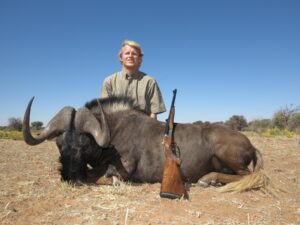Black Wildebeest
A large horse-like antelope.
Gnus (pronounced like “news”), are commonly known as wildebeests…large African antelopes. These animals are extremely fast runners with their maximum running speed being 80 km/hr (50 mph).
Black wildebeest are mainly characterized by their long, white horse-like tail and the dark-colored hair under their belly in between their forelegs.
The coat of the black wildebeest ranges from dark brown to black which can be slightly paler during the summer and coarser and shaggier during the winter. Males will typically have darker coats than females.
Similar to the Blue Wildebeest, they have bushy manes tipped with a dark-brown color that sticks up at the back of their neck. This mane is usually a mass of white or creamy white hair with dark tips. You will also notice black bristly hair under the jaw and on the muzzle.
Both black and blue wildebeest are native to Africa. The black wildebeest mainly prefers dwelling in the open grasslands while its blue counterpart can live in different types of habitat ranging from open grasslands to woodlands and even semi-desert areas.

Hunting The Black Wildebeest
…A Few Things To Know
Both male and female black wildebeests have strong horns that curve forward in a downward motion before going up like hooks. The horns can be as long as 78 cm (30 inches) althrough the horns of females are somewhat thinner and shorter. As the animal matures, the flattened base of their horns become wider and thicker forming a protective sheild around their skull. , then down before curving back up.
The average weight of black wildebeest ranges between 110-180 kg (240-400 lbs) and the average head-body length is between 170-220 (67-87 inches). Males of this species are usually taller than females with average shoulder height of males being 111-121 cm (44-48 inches) while females will be around 106-116 (42-46 inches).






